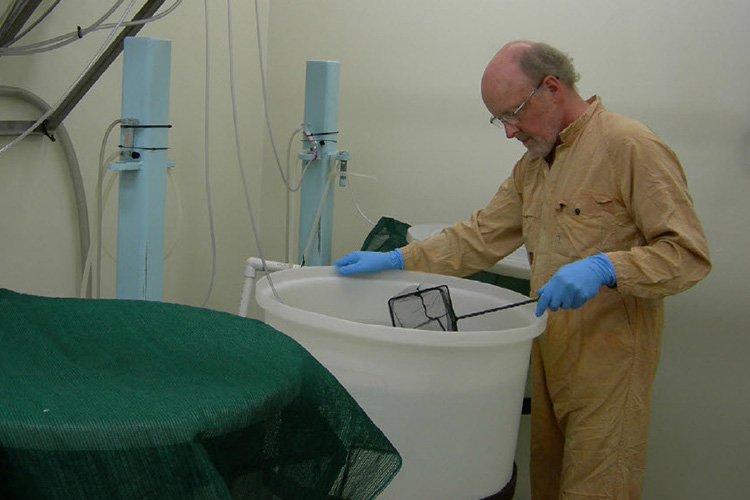We use cookies to give you a better experience on our website. Learn more about how we use cookies and how you can select your preferences.
Invasive Animals CRC - researchers confident of gaining control of carp issue

Dr Ken McColl is helping find new solutions to controlling carp.
Funding finds biological control is the answer
Australia’s carp problem may have finally met its match if the hope of researchers and experts behind the proposed answer - the cyprinid herpesvirus (CyHV-3) – proves well founded.
The potential biological control method has been investigated for several years by researchers at CSIRO’s Australian Animal Health Laboratory in collaboration with the Invasive Animals Cooperative Research Centre.
The economic impact of carp has been estimated at up to $500 million per year.
Carp are one of the worst introduced freshwater aquatic species in Australia, colloquially known as the ‘rabbits of the river’.
Carp have major negative impacts on water quality and the amenity value of our freshwater rivers and lakes. This affects all water users, including irrigators and regional communities. Carp also have a devastating impact on biodiversity, and have severely impacted native fish populations in many areas since they first became established as a major pest fish in the 1960s.
Since 2005, the Invasive Animals CRC has been supported by $49.3 million in Australian Government funding from the CRC Program to investigate and deliver world leading controls for invasive pest animals that are humane, cost efficient and ecologically appropriate.
Based on our rigorous scientific observations over the past eight years, we are confident that the carp herpesvirus only kills carp and does not infect, and therefore cannot affect, a wide range of non-target animals in Australia.
One adult female carp can produce up to a million eggs during a breeding cycle and the omnivorous fish’s tolerance for a wide range of habitats, including degraded water, explains their dominance.
In some parts of the Murray Darling Basin, carp make up a massive 80-90 per cent of the fish biomass.
CyHV-3 is a naturally occurring strain of carp herpesvirus that currently does not occur in Australia.
Years of rigorous testing by the CSIRO, through the Invasive Animals CRC, has shown that the carp herpesvirus will not infect, or affect, a wide taxonomic range of non-target animals.
One sub-project was to test six species with CyHV-3. They were eels, salmon-tailed catfish, rainbowfish, eel-tailed catfish, sea mullet and Australian smelt. There was no histological or molecular evidence for infection of these species.
Chickens and mice, representing birds and mammals, were also challenged with CyHV-3, again with no clinical signs of disease in these species.
Use of the carp herpesvirus will not totally eradicate carp. Whenever a virus is used as a biological control agent, the virus kills large numbers of the target for the first couple of years. But gradually, over time, some resistance builds up. However, numbers never recover to their original levels. Additional tools will be required to complement the virus and to control residual carp populations over the longer term.
Considerable work is required before a release of carp herpesvirus could occur, including further research into how to manage the release and clean up, and into ecological impacts, as well as legislative approvals and community consultation.
As a zoologist, I’m honoured to have the opportunity to make an environmental difference to Australia’s river systems, and as a veterinarian, I’m pleased that there is no evidence that the virus will affect other animals. We’re now working on how to deliver the virus to get maximum impact.
The National Carp Control Plan will focus on maximising the reduction of carp populations while minimising disruption to industries, communities and the environment should a carp herpesvirus release go ahead. The Australian Government has committed $15 million to support this plan.
The plan, while still some way to being rolled out, is being billed as the Australian Government’s great hope in the fight, to effectively manage one of the most devastating pests within the nation’s waterways.
Download CRC for Invasive Animals' customer story
pdf · 0.22 MB